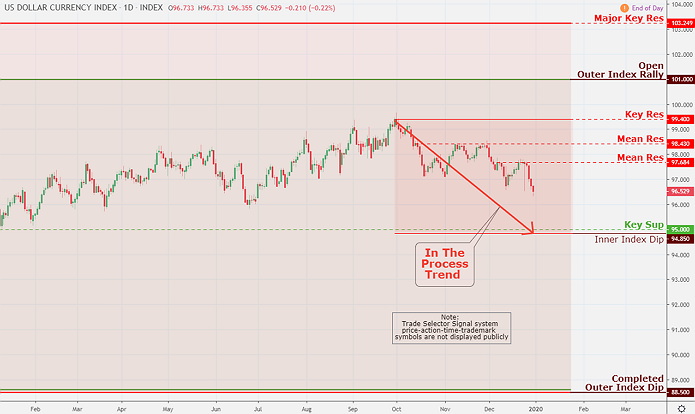Market Commentary & Analysis January 1, 2020

The market vulnerability of the U.S Dollar Index on Tuesday was the extended weakness, posting a -0.22% by closing at 96.53. This was the 6th consecutive losing day not seen since the end of June of 2019: However, Gold and Silver are rising.
Whether or not it is due to the Federal Reserve's augmentation of their balance sheet, the ever-increasing United States deficits on the surge in interest rates overseas, or some other things. I do think this event will be a remarkable story this year. And if accurate that the U.S. Dollar continues to fade - the outcome flow could be massive.

Click the Image to Enlarge
Technical Analysis and Outlook: The index (DXY) is in line posting bearish trend that leads to Key Sup $95.00 and Inner Index Dip $94.85 outcome. But, there has been one 'precious' angle of the DXY possibly making a significant reversal and challenge Mean Res $97.68, $98.43, and ultimately hit Key Res $99.40.
Gold and Silver market will be a benefactor
Just to name a couple, foreigners have hoarded American corporate credit markets on an unhedged footing and only latterly unhedged in the United States Treasury market, who will in both cases get squeezed and could invert with higher American rates.
EM's (Emerging Markets) will profit as will American multinationals that are not hedged. Much higher inflation could happen on the goods front, adjacent to commodity prices.
Some things to follow, and I continue to be bullish on Gold as well as Silver that would benefit big time. However, the most significant thing to observe is the direction of negative-yielding bonds as it could have a straightforward impact on high American rates, additionally to the U.S. Dollar.
By the way, that amounts topped on August 29th last year at $17.04 Trillion and as of December 31 (following the bond selloff), which holds at $11.2 Trillion.
In closing, where interest rates go could very well define where stock markets will go recognizing the symbiotic connection between the two.
Stock market records continue post-Christmas week
The market majors all closed higher. DJI Average closed +76.30 at 28,538, Nasdaq Composite posted +26.60 to finish at 8,973, and broader S&P 500 print a +9.49 to conclude at 3,231.
The S&P 500 index improved 0.3% on this New Year's Eve trading, wrapping up an extraordinary 2019 with a 28.9% increase. The DJI Average, Nasdaq Composite, as well as small-cap Russell 2000 indices also progressed 0.3% each to stretch their 2019 gains to 22.3%, 35.2%, and 23.7%, apiece.
December 31 trading action was tight-ranged as we hinted a probable sluggish trading session on Wall Street, in the comments Russell 2000 Index, Daily Chart Analysis December 28 box.
Amid a lack of price action for most of the trading session, investors and traders buying interest renewed in the closing hour of the session, which helped the stock market to close at day highs.
All eleven S&P 500 sectors ended in the positive area, with the materials sector posting +0.8%, energy sector print +0.7%, and real estate sector finishing with +0.6% - these sectors moving the most.
Major corporate news was very light; however, it is worth noting that Apple closed +2.13, extending its yearly gain with +0.7% to post an impressive 86.2%.
United States Treasuries ended the thinly-traded market session on a much lower note. The Two-year yield rose one basis point to close at 1.57%, posting a -93 bps for 2019.
While the Ten-year yield grew two basis points to finish at 1.92%, posting a -77 bps for 2019. West Texas Intermediate (WTI) crude oil faded 0.75%, or $0.46, to close at $61.23/bbl (posting +35.4% for 2019).